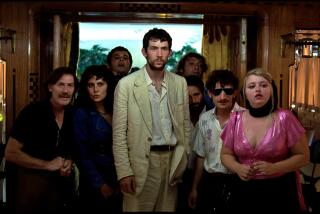White man’s accessory
Hipsters have been traveling to India for decades to imbue their ironic, image-conscious lives with meaning. Blame the Beatles for making it the West’s one-stop country for spirituality (an image from which India has undoubtedly benefited).
So it was only a matter of time before filmmaker and hipster messiah Wes Anderson made the journey. His “Darjeeling Limited” takes as its plot (I use the term loosely) the spiritual quest of the Whitmans, three estranged brothers temple-hopping their way to the Himalayas to meet their also estranged mother, who appears to have found enlightenment of the Catholic missionary stripe rather than the diluted, distorted Hindu variety that the brothers seek. (There’s something for everyone in India!)
As film critic Brian Hu put it , Asian Americans “emitted a collective groan upon hearing the premise.” The movie looked like it would be an Indian transposition of another hipster mock-epic journey East Sofia Coppola’s “Lost in Translation.” That film shares many qualities with “Darjeeling”: a rich and dutifully ethnic-ish soundtrack, Coppola-laden credits, Marc Jacobs-designed goods, wealthy white aimlessness and pale-pink-underwear-clad leads. Pretty and moody though it might have been, Coppola’s effort took many cheap shots at Japanese people. And when it wasn’t taking cheap shots, it was essentially just using them as an “exotic” backdrop, a substitute for the plot and emotional involvement the film lacked.
“Darjeeling” thankfully avoids the cheap shots (though the film’s emotional turning point problematically relies on a tragic event wherein a person of color suffers a tragedy so a person of whiteness can be fulfilled). But Anderson’s Indian characters speak largely unfettered English; they both welcome and mock their white visitors. The Whitman brothers are the punchlines more often than not (such as when Adrien Brody’s character’s claim that he loves India’s “spicy” smell). And, borrowing from predecessors like Jean Renoir, Satyajit Ray and even more low-brow Bollywood pop fare, Anderson does richly evoke India. He makes brilliant use of his most important set piece, the train, a symbol of journeying, communing and clashing for Indians.
But like “Lost in Translation,” “Darjeeling” relies too heavily on setting-as-story, of lands that magically make epiphanies deeper and love affairs more meaningful. It’s a sort of hipster Orientalism Westerners building an image of themselves and the East by scavenging and stereotyping the East. Only this time, it’s less white man’s burden and more white man’s accessory.
Still, it’s better than portraying Japan and India as fearful places, the norm 20-odd years ago, when yellow peril-type news stories made Americans fear a Japanese economic takeover and when a major blockbuster depicted Indians as eaters of monkey brains and carvers of quivering human hearts.
And although hipsters may be guilty of some Eastern fetishizing, they do something similar for the West. They’re avid image-makers of this part of the world, and the trends they create, or the tendencies they mock, become part of the way the West sees itself and is seen. Anderson is particularly good at image-making, a brilliant chronicler and caricaturist of WASPy subcultures (think of Jason Schwartzmann’s jaunty prep-school beret in “Rushmore” or Gene Hackman’s casual and laughable racism in “The Royal Tenenbaums”). Every movie he makes sparks a trend.
“Darjeeling Limited” manages to be at once Orientalist and self-fetishizing (I’d like to say “Occidentalist,” but that phrase has taken on a scarier, and ironically Orientalist meaning). For each long gaze the camera casts on bright, sari-clad Indian women, it offers a similarly loving glimpse of the well-tailored brothers, with their designer luggage and expensive shoes. The somewhat stereotypical Indian beauty (wide-eyed, waiting to be wooed by the white man) is countered by the uptight, officious Brit (the wife of one of the brothers, who scolds them en route to their father’s funeral). The equality of gaze is captured early on, when Jack Whitman (Schwartzmann) pokes his head out a train window for a smoke and spots said Indian beauty (Amara Karan), also smoking. A proper Indian girl would look away, but she meets his eye (and encounters the rest of him later, in a train bathroom).
The Indian gaze is key the main problem with what was actually deemed “Orientalism” decades ago was that there was no room for an Eastern response. That’s changing. Bollywood routinely depicts the West using blonds as slightly slutty backup dancers, or portraying Americans (and, notably, Indian Americans) as corrupt or oversexualized. Japanese fashion cleverly incorporates and exaggerates bits of Western culture.
So for every American film that uses the East as a pretty piece of scenery, and for every lamentably silent Indian in a Wes Anderson movie, there’s a living East and a loud Indian, possibly making fun of white people, beamed to audiences around the world.
Swati Pandey is a researcher for The Times’ editorial pages.
More to Read
A cure for the common opinion
Get thought-provoking perspectives with our weekly newsletter.
You may occasionally receive promotional content from the Los Angeles Times.






